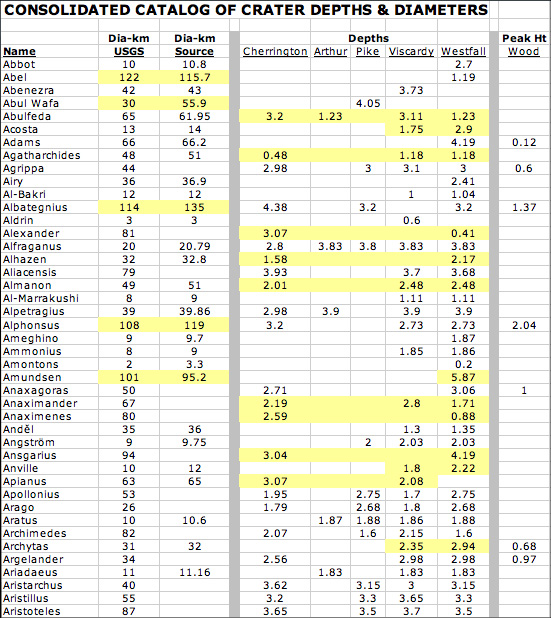
image by Chuck Wood, Wheeling, WV
This is the most boring LPOD image of the year. But it demonstrates a need and an opportunity. The excerpt of a spreadsheet above lists 43 craters and their diameters and depths. Of these, 5 (or 12%) have two measures of diameters that disagree (yellow) by more than 5-10%; surely, we can determine if Alphonsus is 108 or 119 km wide? And for 13 of the craters (30%), estimates of depths disagree by 1 to 2 km! Is Abulfeda 1.2 km deep or 3.2? And this list doesn’t include craters where no depths are available at all! Recently, three amateurs - Kurt Fisher, Jim Mosher and Henrik Bondo - have contributed tools that allow a new evaluation of lunar topography. Kurt has industriously compiled digital databases of previous measurements of lunar crater depths and diameters, from which I constructed the figure above. And the Lunar Terminator Visualization Tool software created by Jim and Henrik provides the easiest way ever to measure lunar dimensions. Add to these tools the annual production of hundreds of high resolution lunar images by talented observers and everything needed for a revolution in lunar topography is at hand. (A) I encourage individuals to continue to acquire high res lunar images - especially near enough to the terminator so that crater rim shadows fall on their floors. (B) I encourage someone/s to create a complete catalog such as the sample above that identifies where dimensional measures are needed either because they are missing or existing data conflict. (C) And I encourage various people to become proficient enough with LTVT so that they can routinely determine high precision crater diameters and depths. Following these As, Bs and Cs a comprehensive catalog of accurate lunar crater dimensions can be compiled. Similarly, heights and slopes of peaks, domes, scarps, rilles and central peaks can be determined. Four hundred years after Galileo first estimated sizes of lunar features, we still don’t have comprehensive cataloging of lunar topography, but now it is possible for amateurs to do the job!
Technical Details:
There are many details yet to be given about the list above and how to accurately measure shadow lengths. If there is interest in doing this work - individuals can work alone or collaborate - I can write more explicit suggestions.
Related Links:
Crater depths
Yesterday's LPOD: 1 Eclipse, 2 Telescopes & 58 Images
Tomorrow's LPOD: Land of Milk and Honey and Rilles
COMMENTS?
Register, Log in, and join in the comments.



